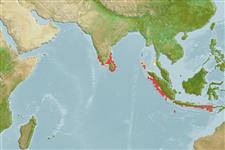Actinopterygii (ray-finned fishes) >
Perciformes (Perch-likes) >
Serranidae (Sea basses: groupers and fairy basslets) > Epinephelinae
Etymology: Epinephelus: Greek, epinephelos = cloudy (Ref. 45335).
Environment / Climate / Range
Ecology
Marine; reef-associated; depth range 1 - 125 m (Ref. 89707), usually 1 - 12 m (Ref. 90102). Tropical, preferred ?; 16°N - 11°S, 75°E - 121°E (Ref. 5222)
Eastern Indian Ocean: southern India, Sri Lanka, and southern Indonesia. However, it is likely that its distribution is continuous from Pakistan to Indonesia. Record from the Chagos Archipelago is based on Epinephelus macrospilos (Ref. 6495).
Size / Weight / Age
Maturity: Lm ? range ? - ? cm
Max length : 32.0 cm TL male/unsexed; (Ref. 5222)
Dorsal
spines
(total): 11;
Dorsal
soft rays
(total): 16-18;
Anal
spines: 3;
Anal
soft rays: 8. Distinguished by having whitish or pale grey color; head, body and fins with numerous close-set round brown spots of unequal sizes; cycloid scales except region under pectoral fins; body with numerous auxiliary scales; greatest depth of body 3.0-3.5 in SL; rounded caudal fin; pelvic fins, 2.2-2.7 in head length (Ref. 90102); further characterized by flat or slightly concave interorbital area, convex dorsal head profile; rounded preopercle, with shallow indentation just above angle and slightly enlarged serrae at the angle; upper edge of operculum slightly convex; subequal posterior and anterior nostrils; maxilla reaches past vertical at rear edge of eye; 2 rows of teeth on midlateral part of lower jaw (Ref. 89707).
Occurs in shallow waters over coral reefs or rocky substrate. It appears to be a small species; a 17 cm SL fish from Sri Lanka has fairly well-developed ovaries. Solitary (Ref 90102).
Life cycle and mating behavior
Maturity | Reproduction | Spawning | Eggs | Fecundity | Larvae
Heemstra, P.C. and J.E. Randall, 1993. FAO Species Catalogue. Vol. 16. Groupers of the world (family Serranidae, subfamily Epinephelinae). An annotated and illustrated catalogue of the grouper, rockcod, hind, coral grouper and lyretail species known to date. Rome: FAO. FAO Fish. Synop. 125(16):382 p. (Ref. 5222)
IUCN Red List Status (Ref. 115185)
CITES (Ref. 94142)
Not Evaluated
Threat to humans
Harmless
Human uses
Fisheries: commercial
More information
Common namesSynonymsMetabolismPredatorsEcotoxicologyReproductionMaturitySpawningFecundityEggsEgg development
ReferencesAquacultureAquaculture profileStrainsGeneticsAllele frequenciesHeritabilityDiseasesProcessingMass conversion
Tools
Special reports
Download XML
Internet sources
